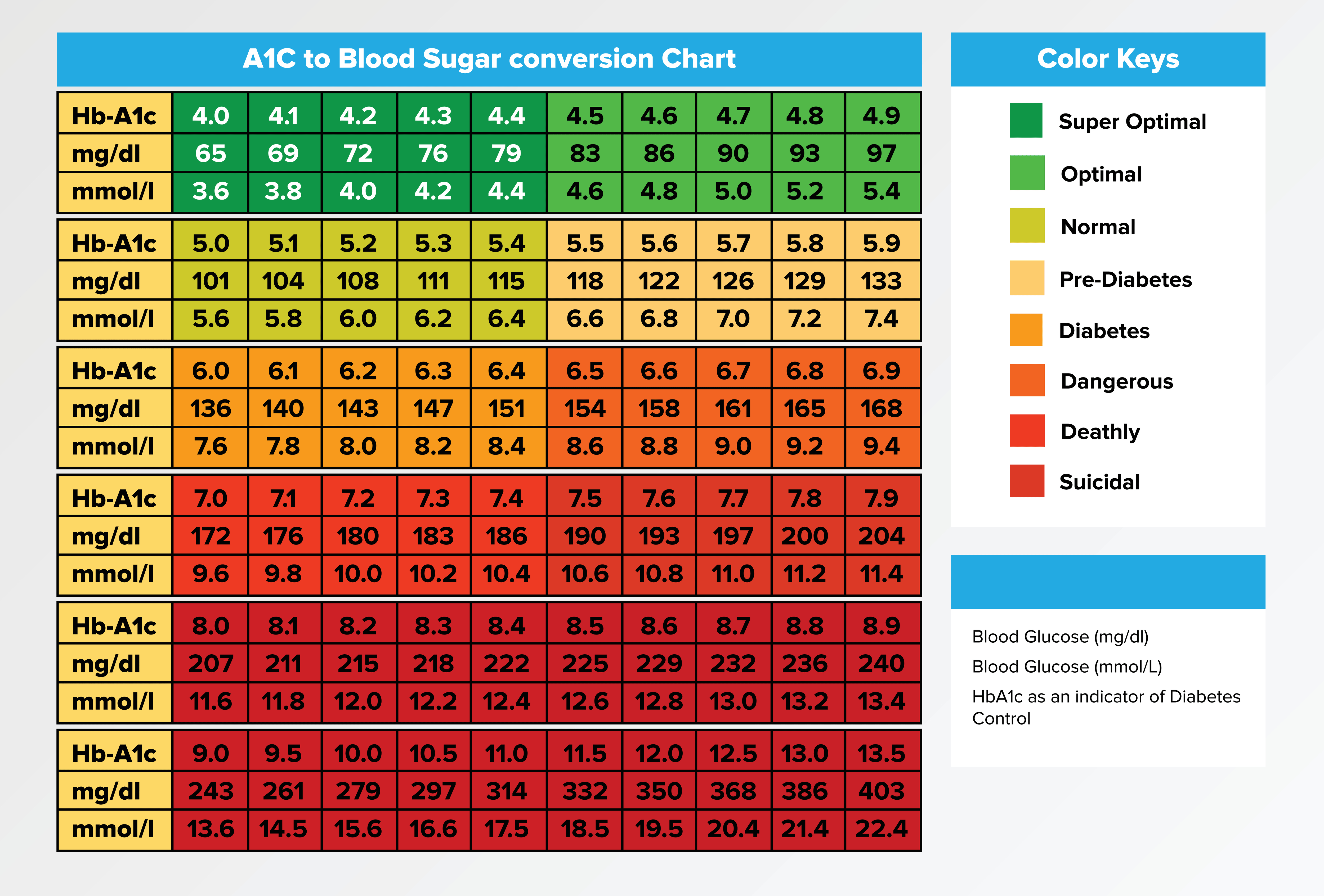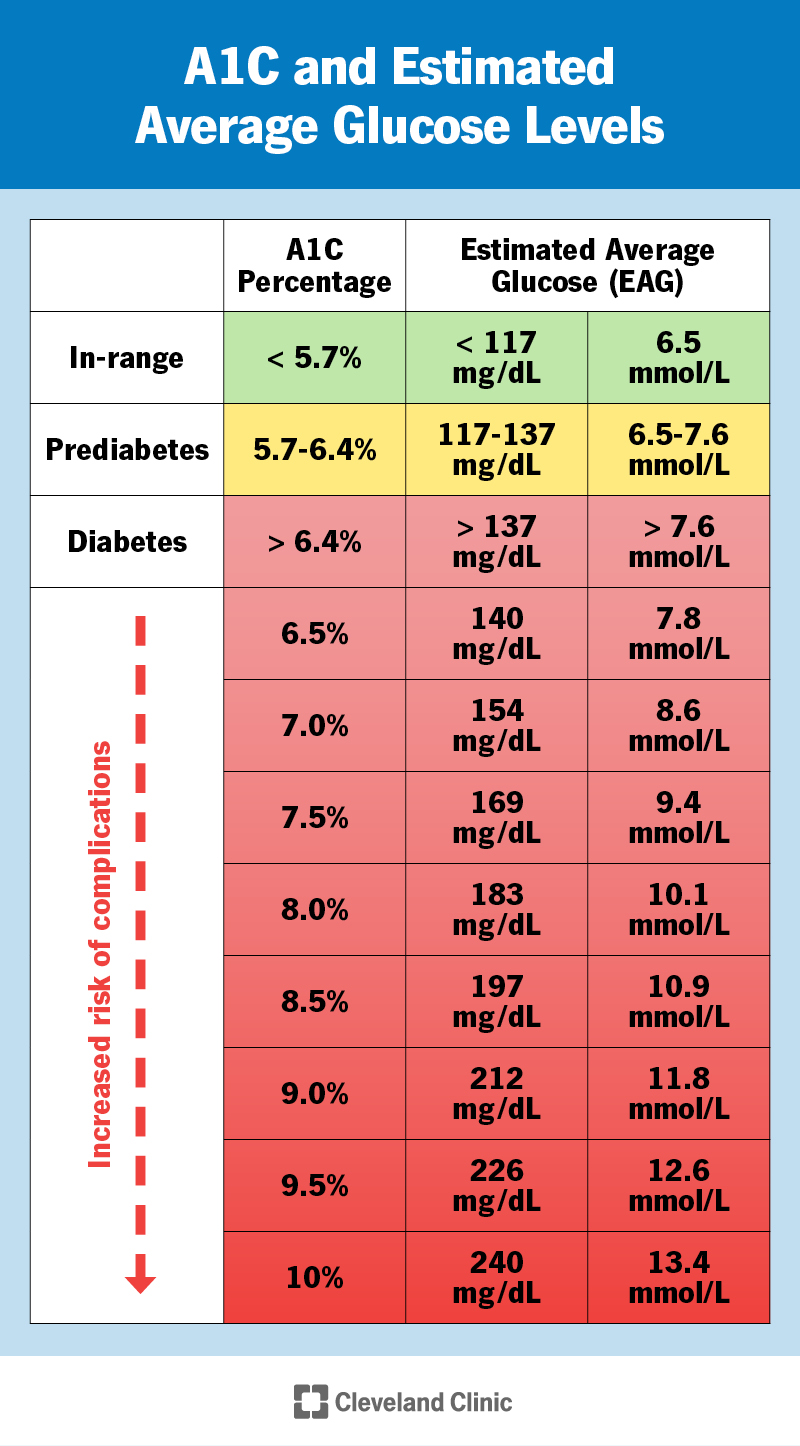Understanding Normal A1C Levels: A Complete Guide & More
Are you truly in control of your blood sugar? The stark reality is that maintaining healthy A1C levels is non-negotiable if you want to safeguard your health and prevent the debilitating complications of diabetes. A1C, scientifically known as hemoglobin A1C or HbA1C, isn't just another medical term; it's a critical blood test revealing your average blood sugar control over the preceding 2 to 3 months. Typically, normal A1C levels hover between 4% and 5.6%.
The significance of A1C levels lies in their ability to pinpoint individuals at risk of developing diabetes and its associated complications. Elevated A1C levels correlate directly with an increased susceptibility to heart disease, stroke, kidney disease, and a host of other severe health issues.
A multitude of factors can influence A1C levels, including dietary choices, physical activity, and medication adherence. For individuals diagnosed with diabetes, collaborating closely with their healthcare provider is paramount to effectively manage their A1C levels and minimize the risk of developing complications.
- Who Is Tim Scotts Daughter All About Jenn Scott Updated
- Vegamovies 4k Hindi Dubbed Watch Hindi Movies Online
| Category | Details |
|---|---|
| Name | A1C (Hemoglobin A1C) |
| Description | A blood test reflecting average blood sugar levels over the past 2-3 months. |
| Normal Range | 4% - 5.6% |
| High Risk Indication | 6.5% or higher (indicates diabetes) |
| Importance | Identifies risk for diabetes, heart disease, kidney disease, stroke. |
| Management Factors | Diet, exercise, medication, regular monitoring |
| Frequency of Monitoring | At least twice a year for diabetics, more frequent if poorly controlled. |
| Complications of High A1C | Heart disease, stroke, kidney failure, blindness, nerve damage |
| Source | American Diabetes Association |
A1C levels stand as an indispensable gauge of blood sugar regulation over time, making the maintenance of normal levels vital for holistic health. Several core considerations bear emphasis:
- Definition: A calculation reflecting average blood glucose levels over a period of 2-3 months.
- Range: Typical normal A1C values reside between 4% and 5.6%.
- Importance: Heightened A1C levels amplify the potential for diabetes and consequential complications like cardiovascular disease and renal insufficiency.
- Management: Consistent monitoring, dietary adjustments, exercise regimens, and medicinal interventions collectively contribute to upholding healthy A1C levels.
- Monitoring: A1C assessments should occur at least biannually for individuals with diabetes, and more recurrently for those exhibiting suboptimal blood sugar control.
Sustaining normal A1C concentrations proves fundamental in averting or postponing the advent of diabetes and its associated sequelae. Grasping these central facets empowers individuals to proactively manage their blood glucose and foster their overall health and well-being.
A1C levels deliver a thorough synopsis of an individual's blood sugar management across a prolonged duration, contrasting with sporadic blood sugar evaluations, which capture only an isolated instance. This protracted monitoring window permits a more precise appraisal of a person's comprehensive glucose regulation and diabetes oversight.
- Is Sabrina Carpenter The Next Hermione Harry Potter Saga
- Who Is Sophie Aspin A Deep Dive Into Nudostars Life Impact
- Long-Term Monitoring: A1C metrics constitute a precious instrument for healthcare experts to gauge the efficacy of diabetes management strategies, encompassing medication, nutritional guidance, and lifestyle modifications.
- Early Detection: Augmented A1C readings can act as an initial cautionary indicator for individuals at elevated risk of developing diabetes or prediabetes, facilitating prompt interventions to forestall or delay the onset of the ailment.
- HbA1c and Diabetes Diagnosis: A1C readings fulfill a pivotal function in diagnosing diabetes. As per the American Diabetes Association, an A1C value of 6.5% or greater across two independent evaluations signifies diabetes.
- Monitoring Treatment Efficacy: Periodic A1C analysis aids healthcare practitioners in assessing the impact of diabetes treatment blueprints and instituting required alterations to fine-tune blood sugar regulation.
By comprehending the relevance of A1C concentrations as a metric of average blood sugar densities spanning time, individuals can energetically partake in administering their diabetes and mitigating the prospect of ramifications.
Grasping the normal spectrum of A1C readings stands vital for gauging blood sugar oversight and competently navigating diabetes. Typical A1C values, usually fluctuating between 4% and 5.6%, function as a yardstick for optimal blood sugar governance and curtailed threat of diabetes entanglements.
Preserving values within the normal A1C bandwidth furnishes several merits. Foremost, it notably diminishes the potential for cultivating diabetes-linked adversities, such as cardiac ailments, strokes, renal decline, and visual impairment. Consistently maintaining normal A1C levels aids in averting harm to blood vessels and vital organs, thereby safeguarding overarching health and wellness.
Next, attaining and sustaining normal A1C concentrations can elevate an individual's life quality. Sound blood sugar regulation augments vigor thresholds, alleviates exhaustion, and fosters enhanced slumber. It also lends itself to refined cognitive processes, disposition, and holistic sensation of well-being.
In essence, decoding the normal A1C range remains indispensable for individuals afflicted with diabetes or at risk of progressing toward the ailment. By endeavoring to uphold A1C values within the advocated bandwidth, individuals can proactively curtail their susceptibility to complications, elevate their life quality, and optimize their comprehensive health trajectories.
Maintaining normal A1C values looms of supreme import in overseeing diabetes and lessening the odds of its interconnected predicaments. Elevated A1C readings function as a compelling harbinger of inadequate blood sugar oversight, which can precipitate dire health sequelae. Several perspectives illuminate this nexus:
- Increased Cardiovascular Risk: Heightened A1C values have been correlated with an amplified susceptibility to cardiovascular complications, including cardiac ailments and strokes. Chronically escalated blood sugar intensities corrode blood vessels, rendering them more vulnerable to plaque deposition and constriction, which can impede blood circulation and culminate in myocardial infarctions or strokes.
- Kidney Damage: Protracted contact with elevated blood sugar intensities can impair renal function. Heightened A1C values escalate the odds of developing diabetic nephropathy, a state typified by injury to the delicate filtering mechanisms within the kidneys, potentially engendering renal failure and the necessity for dialysis or transplantation.
- Retinal Damage: Elevated blood sugar concentrations can also compromise the blood vessels within the retina, giving rise to diabetic retinopathy. This affliction can precipitate blurred vision, visual impairment, and even blindness if left unattended.
- Neuropathy: Heightened A1C values can equally trigger nerve deterioration or neuropathy, eliciting numbness, tingling, and pain within the hands, feet, and legs. Severe neuropathy can impact equilibrium, coordination, and the aptitude to execute daily undertakings.
In conclusion, maintaining normal A1C values looms pivotal in deterring the genesis and progression of grave health ramifications interwoven with diabetes. By grasping the hazards affiliated with heightened A1C readings, individuals can prioritize efficacious blood sugar management, curtailing their vulnerability to these incapacitating ailments and conserving their holistic well-being.
Maintaining normal A1C values constitutes a keystone of fruitful diabetes administration and prevention. Routinely monitoring blood sugar concentrations, coupled with a wholesome lifestyle and apt medicinal intervention, assumes a pivotal function in attaining and sustaining superlative A1C values.
Consistent blood sugar oversight empowers individuals to monitor their glucose concentrations and discern patterns. This knowledge empowers them to render informed judgments concerning their diet, exercise, and medication, assuring they remain within the advocated A1C spectrum. Moreover, routine monitoring aids healthcare specialists in gauging the impact of treatment strategies and instituting requisite adaptations to optimize blood sugar regulation.
Embracing a balanced dietary regimen proves indispensable for administering A1C values. Selecting consumables sparse in carbohydrates and sugar, while prioritizing fruits, vegetables, and whole grains, aids in modulating blood sugar concentrations and thwarting spikes. Consistent exercise forms another critical constituent, as it refines insulin sensitivity and fosters glucose utilization, contributing to diminished A1C values.
In specific scenarios, medicinal intervention may prove requisite to efficiently administer A1C values. Oral medications or insulin therapy can aid in reducing blood sugar concentrations and enhancing A1C readings. Nonetheless, adhering to prescribed medicinal regimens and collaborating closely with healthcare practitioners to track advancement and modify dosages as warranted remains paramount.
By embracing routine monitoring, embracing wholesome lifestyle habits, and adhering to medicinal blueprints, individuals can efficaciously sustain normal A1C values. This proactive methodology not only mitigates the potential for diabetes entanglements but also nurtures overarching well-being and life quality.
Monitoring A1C values represents a critical component of impactful diabetes administration, furnishing invaluable perspectives into an individual's average blood sugar governance over time. Regular A1C evaluations empower healthcare experts to gauge the impact of treatment strategies and render informed judgments concerning requisite adaptations to optimize blood sugar regulation.
For individuals afflicted with diabetes, maintaining normal A1C values stands paramount in curtailing the potential for cultivating grave health adversities, encompassing cardiac ailments, strokes, renal decline, and visual impairment. Routine A1C oversight aids in assuring that blood sugar concentrations linger within the advocated spectrum and that apt interventions are implemented to forestall or delay the genesis of these entanglements.
The recurrence of A1C monitoring may fluctuate contingent upon an individual's specific circumstances and blood sugar governance standing. For those exhibiting well-governed blood sugar concentrations, biannual A1C evaluations may suffice. Nevertheless, for individuals with inadequately governed blood sugar, more recurrent oversight is advocated to track advancement and institute requisite modifications to treatment blueprints in a timely manner.
Adhering to advocated A1C monitoring timetables empowers healthcare experts to proactively discern and address any apprehensions or shifts in blood sugar governance, enabling prompt interventions to sustain optimal A1C values and minimize the potential for entanglements. Routine A1C oversight empowers individuals with diabetes to assume an active function in administering their ailment and preserving their overarching health and well-being.
Individuals soliciting data on normal A1C values frequently harbor specific queries and misgivings. This section addresses some recurrently posed inquiries, furnishing succinct and illuminating responses.
Question 1:What constitutes the advocated A1C spectrum for individuals with diabetes?
Answer:The American Diabetes Association advocates an A1C objective of below 7% for the majority of individuals with diabetes. This targeted spectrum aids in mitigating the potential for cultivating diabetes-linked adversities, such as cardiac ailments, strokes, and renal decline.
Question 2:How frequently should I undergo A1C evaluations?
Answer:The recurrence of A1C testing may fluctuate contingent upon individual circumstances and blood sugar governance standing. Generally, individuals with diabetes are advised to undergo A1C evaluations at least biannually. More recurrent oversight may prove requisite for those exhibiting inadequately governed blood sugar.
In synthesis, maintaining normal A1C values looms pivotal for administering diabetes efficaciously and curtailing the potential for entanglements. Routine A1C oversight, amalgamated with a wholesome lifestyle and apt medicinal intervention, empowers individuals to attain and sustain superlative blood sugar governance. Consulting with healthcare experts and adhering to advocated oversight timetables remains indispensable for triumphant diabetes administration and preserving overarching health and well-being.
Normal A1C values stand vital for upholding sound health and averting entanglements intertwined with diabetes. By grasping the significance of A1C values, individuals can undertake proactive measures to administer their blood sugar and curtail their susceptibility to cultivating diabetes or its adversities. Routine oversight, in conjunction with a wholesome lifestyle and apt medicinal intervention, constitutes cardinal components of efficacious A1C administration.
Maintaining normal A1C values empowers individuals to seize command of their health and well-being. By collaborating intimately with healthcare experts and adhering to advocated directives, individuals can attain and sustain optimal blood sugar governance, curtailing the potential for diabetes-related entanglements and enhancing their overarching life quality.
- Vegamovies 4k Is It The Future Of Streaming Or Just Hype
- Vegamovies Ist Is It Safe Legal The Ultimate Guide

Know What A1c Test Measures, Conversion Calculator, Ranges & Tips

Hemoglobin A1c Test Cost Just at 29 Order Online & Get Tested

farmakológia nastaviť výslovne hba1c calculator Lekárske nezákonné